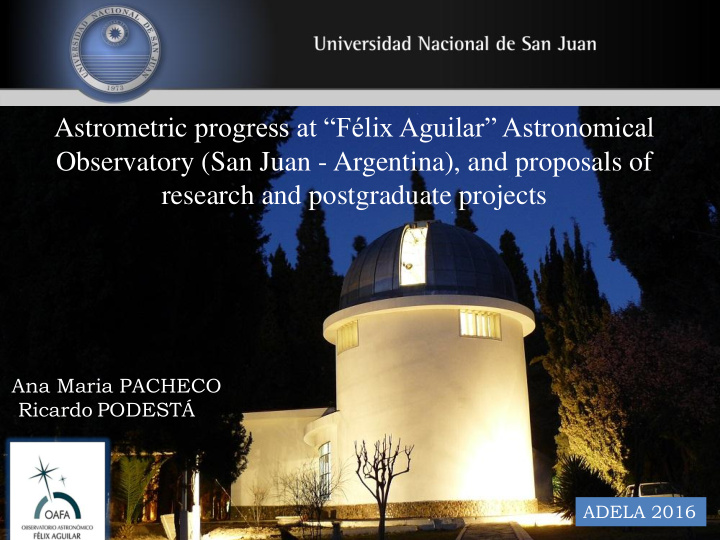



Astrometric progress at “Félix Aguilar” Astronomical Observatory (San Juan - Argentina), and proposals of research and postgraduate projects Ana Maria PACHECO Ricardo PODESTÁ ADELA 2016
Astronomical Station: CARLOS U. CESCO 2400m amsl
1) ASiPEG -Double Astrograph Telescope Stellar proper motion determination as regards external galaxies (SPM) Follow-up of Asteroids in the Asteroid Main Belt and NEOs. Comet physical follow-up and studies. Asteroids photometry. Theoretical studies on the Solar System collisional evolution. · Differential photometry
2) Meridian Astrometry Automatic Meridian Circle Real Instituto Observatorio de la Armada (ROA)- Spain OAFA It is intended for the measurement of stars and planets coordinates and magnitudes located between +40 and -55 ° declination. So far, since the setting up of the CCD camera, some 15,000,000 individual positions have been observed, most of which have been carried out on celestial bodies in the southern hemisphere.
3) Solar Area Mirror Coronagraph of Argentina MICA observes the solar corona above the limb (from 1.05 to 2.0 solar radii from Sun center) in various spectral ranges ( l 5303, l 6374, l 6563). Scientific Goals: - Coronal physics - Environmental research
HASTA: H - A lpha S olar T elescope of A rgentina RESEARCH TASKS - Study the evolution of solar flares with high spatial (2.07 arcsec) and temporal (up to 0.5 sec) resolution - Eruptive prominences and coronal mass ejections - Loops interconnecting active regions, Moreton or other waves that spread all over the solar surface.
4) ExtraMeridian Astrometry DANJON ASTROLABE
PHOTOELECTRIC ASTROLABE PAII A FIFTEEN YEAR OLD EXPERIENCE OF INTERNATIONAL COOPERATION Automated Photoelectric Astrolabe Telescope PAII (1992 -2007) According to a cooperation agreement between Chinese Academy of Sciences, CONICET and San Juan National University, in February 1992 was set up at Félix Aguilar Astronomical Observatory of San Juan (Argentina) the Photoelectric Astrolabe Mk 2 (PA2).
IERS Astrometry Geodesy Space Measurement Techniques VLBI LLR SLR GNSS DORIS
In 2005 the agreement was enlarged by the setting up of an SLR telescope, and just recently, of a permanent GPS station. Satellite Laser Ranging ILRS 7406 Permanent GPS Station
A threefold frequency (GPS, GLONASS and BEIDOU) receiver supplied by the NAOC will be soon set up. Dome SLR Antenna GPS Pillar Beidou Pillar built for the Beidou antenna
Late 2016 early 2017 a DORIS ((Doppler Orbitography and Radiopositioning Integrated by Satellite) Station will be set up at OAFA, through an agreement with the IGN in France Representation of the DORIS beacon once installed Transmitter
CART PROYECT ( C hinese A rgentine R adio- T elescope) Radiotelescope 40 meters to be installed in San Juan, for observation from Southern Hemisphere. Radio frequencies 1 - 45 GHz.
CART ICRF (SH) setting up and maintainance Correlations between the radio reference frameworks and the Astrophysics reference frameworks of other wave longitudes EOP determination Study of Radiosources and their Others… Geodesy structure changes AGN redshift Observations of X-ray binaries, supernovae and novae envelopment Geodynamic studies of the Earth Deep Space Planetary crust – Earth tectonic plates Exploration Science movements ……. Contribute to the space exploration joining the Chinese Lunar Exploration Program (CLEP)
Postgraduate studies Doctorates in Astronomy: Universities of La Plata, Córdoba and San Juan Doctorate in Geodesy Expert on Georeferentiation UNSJ (1 year) 950 hs. Addressed to graduates in Land Surveyor Engineering, Geodesy Expertise, Geography Engineering or Astronomy. San Juan: There is the possibility to match courses in China on Space Geodetic Techniques. Courses either in China or in Argentina out of the ongoing agreement between the UNSJ and the NAOC. As a record, there are doctorates already completed and some other ones accepted.
ADELA 2016 To foster and strengthen the development of scientific projects through international collaboration among the Latin- American countries. To explore mutual strategies to promote academic and scientific exchange that may make the above mentioned topics easier (including theses subject matter, grants for students, postdoctoral chances for young researchers, etc.) We encourage everyone who is interested in Astrometry and Space Geodesy to support or take part in our projects at OAFA. You will be welcome. Thank you!
Recommend
More recommend